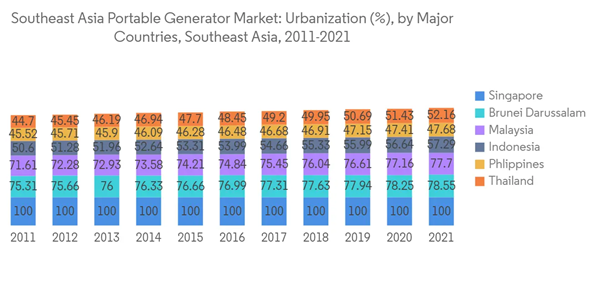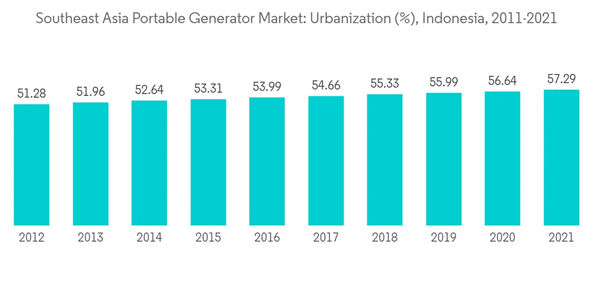The Southeast Asian portable generator market is projected to register a CAGR of over 3.5% during the forecast period.
The market was negatively impacted by COVID-19 in 2020. Presently, the market has reached pre-pandemic levels.
This product will be delivered within 2 business days.
The market was negatively impacted by COVID-19 in 2020. Presently, the market has reached pre-pandemic levels.
Key Highlights
- Over the medium term, factors such as the ever-increasing demand for power, lack of reliable grid infrastructure, the need for emergency backup power solutions, and the demand for a steady power supply are expected to drive the Southeast Asian portable generator market.
- On the other hand, the increasing demand for battery storage systems and other cleaner sources of standby power is expected to restrain the growth of the Southeast Asian portable generator market.
- Nevertheless, the commercial and industrial sectors of emerging economies, the residential sector of developed economies, and the increasing need for power in defense operations are expected to create significant opportunities for market players in the near future.
- Indonesia accounted for the largest share of the market in 2021 due to increasing urbanization, leading to a demand for power.
Southeast Asia Portable Generator Market Trends
Residential Sector to be a Significant Market Segment
- The residential segment is expected to continue to grow and dominate the portable generators market, mainly as a result of the prevalent installation of generators throughout households to ensure the availability of emergency power during a power outage or grid failure. According to the International Energy Agency (IEA), Southeast Asia's energy demand has grown on average by 3% a year over the past two decades, and this trend is expected to continue through 2030.
- According to the ASEAN Center for Energy (ACE)'s ASEAN Energy Database System, the residential sector accounts for 30% of electricity demand in the region. Furthermore, household electrical appliances account for the majority of energy use in the residential sector.
- As many people are moving from villages to cities, the region is experiencing exponential urbanization. Urban areas contribute to a significant increase in GDP, encouraging investors to expand their businesses. This results in an increase in electricity demand. Metropolitan cities offer numerous opportunities for employment, business, and leveraging human life. As the urban sector has high growth potential, more people are moving to metropolises. The growth of population density and the expansion of the residential and urban sectors are destined to lead to an increase in market size.
- In August 2022, ICLEI-Local Governments for Sustainability South Asia partnered with ICLEI-Southeast Asia in order to assist the Government of Malaysia in developing Green City Action Plans (GCAPs) for Malaysian cities in partnership with the Asian Development Bank (ADB) and with the support of the Indonesian-Malaysia-Thailand-Growth Triangle (IMT-GT) Joint Business Council (JBC) Malaysia. These urbanization plans are expected to create demand for portable generators.
- Therefore, growing urbanization in the region, rising concerns about power instability in the residential sector due to events such as natural calamities, and the need for uninterrupted operations are driving the Southeast Asian portable generator market.
Indonesia to Dominate the Market
- As a result of increasing infrastructure projects, widening power demand-supply gaps, and the expansion of manufacturing facilities across the nation, Indonesia is expected to lead the Southeast Asian portable generator market. Portable generators have become more affordable and effective in the country. The improved living standards have increased the demand for power backup systems.
- In 2021, in Indonesia, the total electricity consumption per capita was 978 kWh. The total energy consumption increased 3.4% per year between 2013 and 2019 and declined by around 10% in 2020. The consumption will increase by about 4% in 2021.
- Based on the new National Electric Generation Plan for 2021-2030 (RUPTL), Indonesia's electricity demand is expected to grow by 4.9% annually by 2030. At the end of 2022, the electrification ratio is expected to reach 100%, with the electricity demand from 94.1 million customers reaching 445 terawatt hours (TWh). The Indonesian government is considering moving its capital to East Kalimantan, from Jakarta, in order to expand the wealth and development outside of Jakarta.
- During the 2022 State Budget, the central government allocated USD 34 billion for the construction of the new capital. A huge demand for portable generators is expected, considering these infrastructure projects.
- In September 2022, a cooperation agreement between Indonesia and Japan was signed to enhance cooperation in the manufacturing sector by taking strategic measures and realizing commitments made at bilateral and regional forums in Indonesia. Therefore, based on the above-mentioned factors, Indonesia is expected to dominate the Southeast Asian portable generator market during the forecast period.
Southeast Asia Portable Generator Market Competitor Analysis
The Southeast Asian portable generator market is moderately fragmented. Some of the major players (in no particular order) are Honda Motor Co. Ltd, Atlas Copco, Caterpillar Inc., Kohler Power Systems, and Briggs & Stratton Corporation.Additional benefits of purchasing the report:
- The market estimate (ME) sheet in Excel format
- 3 months of analyst support
This product will be delivered within 2 business days.
Table of Contents
1 INTRODUCTION
4 MARKET OVERVIEW
5 MARKET SEGMENTATION
6 COMPETITIVE LANDSCAPE
Companies Mentioned (Partial List)
A selection of companies mentioned in this report includes, but is not limited to:
- Honda Motor Co. Ltd
- Atlas Copco
- Caterpillar Inc.
- Kohler Power Systems
- Briggs & Stratton Corporation
- PRAMAC
- HIMOINSA
- Kirloskar Group
Methodology

LOADING...










